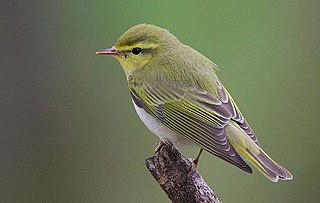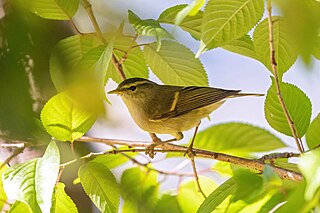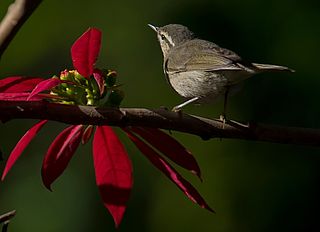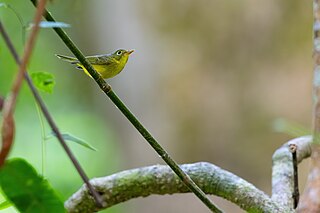
Leaf warblers are small insectivorous passerine birds belonging to the genus Phylloscopus.

The willow warbler is a very common and widespread leaf warbler which breeds throughout northern and temperate Europe and the Palearctic, from Ireland east to the Anadyr River basin in eastern Siberia. It is strongly migratory, with almost all of the population wintering in sub-Saharan Africa.

The wood warbler is a common and widespread leaf warbler which breeds throughout northern and temperate Europe, and just into the extreme west of Asian Russia in the southern Ural Mountains.

The Arctic warbler is a widespread leaf warbler in birch or mixed birch forest near water throughout its breeding range in Fennoscandia and the northern Palearctic. It has established a foothold in North America, breeding in Alaska. This warbler is strongly migratory; the entire population winters in southeast Asia. It therefore has one of the longest migrations of any Old World insectivorous bird.

The greenish warbler is a widespread leaf warbler with a breeding range in northeastern Europe, and temperate to subtropical continental Asia. This warbler is strongly migratory and winters in India. It is not uncommon as a spring or early autumn vagrant in Western Europe and is annually seen in Great Britain. In Central Europe large numbers of vagrant birds are encountered in some years; some of these may stay to breed, as a handful of pairs does each year in Germany.

Pallas's leaf warbler or Pallas's warbler, is a bird that breeds in mountain forests from southern Siberia east to northern Mongolia and northeast China. It is named for German zoologist Peter Simon Pallas, who first formally described it. This leaf warbler is strongly migratory, wintering mainly in south China and adjacent areas of southeast Asia, although in recent decades increasing numbers have been found in Europe in autumn.

The dusky warbler is a leaf warbler which breeds in the east Palearctic. The genus name Phylloscopus is from Ancient Greek phullon, "leaf", and skopos, "seeker". The specific fuscatus is from Latin fuscus "dark".

Radde's warbler is a leaf warbler which breeds in Siberia. This warbler is strongly migratory and winters in Southeast Asia. The genus name Phylloscopus is from Ancient Greek phullon, "leaf", and skopos, "seeker". The specific schwarzi commemorates German astronomer Ludwig Schwarz (1822–1894).

Tickell's leaf warbler is a leaf warbler found in Asia in the countries of Bangladesh, Bhutan, China, India, Myanmar, Nepal, Pakistan and Thailand. The species has a yellowish underside and supercilium. Like other leaf warblers it feeds mostly on insects by gleaning and short sallies. An active bird, it prefers the canopy and low shrubbery and can be difficult to track as it moves actively from branch to branch, acrobatically exploring the underside of leaves and twigs. The clear yellowish undersides and lack of a wing bar can be used to tell it apart from similar species. It has slim dark legs with largely pale lower mandible and grayish wing panel.

The Chinese leaf warbler is a species of Old World warbler in the family Phylloscopidae. Its natural habitats are subtropical or tropical dry forests and subtropical or tropical high-altitude shrubland. It is found only in China.
The Kolombangara leaf warbler or sombre leaf warbler is a species of Old World warbler in the family Phylloscopidae. It is found only in Solomon Islands. Its natural habitat is subtropical or tropical moist montane forests. It is threatened by habitat loss.

The yellow-streaked warbler is a species of leaf warbler. It was formerly included in the "Old World warbler" assemblage.
The Emei leaf warbler is a species of leaf warbler. It was formerly included in the "Old World warbler" assemblage.

The ashy-throated warbler is a species of leaf warbler. It was formerly included in the "Old World warbler" assemblage.

The buff-barred warbler is a species of leaf warbler. It was formerly included in the "Old World warbler" assemblage.

The pale-legged leaf warbler is a species of Old World warbler in the family Phylloscopidae. The species was first described by Robert Swinhoe in 1860. It is found in Manchuria; it winters in Southeast Asia. Its natural habitat is temperate forests.

Tytler's leaf warbler is a songbird species. Like all leaf warblers, it was formerly placed in the "Old World warbler" assemblage, but now belongs to the new leaf-warbler family Phylloscopidae.

The yellow-breasted warbler is a species of Old World warbler in the family Phylloscopidae. It is found in Indonesia, Malaysia, and Palawan Island in the Philippines. The species is most common on the islands of Sumatra and Borneo in Indonesia. Its natural habitats are subtropical or tropical moist lowland forest and subtropical or tropical moist montane forest.

Alström's warbler, or the plain-tailed warbler, is a species of Old World warbler in the family Phylloscopidae. It was first described in 1999. It breeds only in China and winters as far as Thailand, Laos, Cambodia and Vietnam. Its natural habitat is temperate forests.

Whistler's warbler is a species of leaf warbler. It was formerly included in the "Old World warbler" assemblage.




















